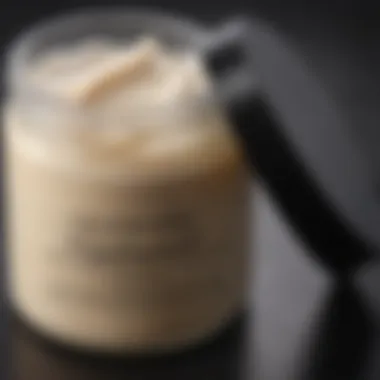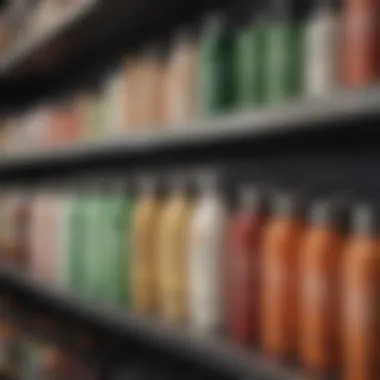Understanding Deep Conditioners for Curly Hair


Intro
Curly hair requires unique care to maintain health and vitality. One essential part of this routine is the use of deep conditioners. These products serve to nourish, hydrate, and repair curly hair that often faces challenges such as dryness and frizz. In this guide, we will specifically explore the role of drugstore deep conditioners tailored for curly hair types.
Understanding how to choose the right deep conditioner can dramatically improve the hair’s texture and overall appearance. Many women often face confusion with the myriad products on the market. This article looks to clarify their effectiveness, formulations, and how they fit into a regular hair care routine tailored for curls.
The focus will be on key trends in hair care aimed at curly textures, popular formulation ingredients that yield great results, and practical techniques applied during the conditioning process. Alongside these insights, this guide aims to provide updated recommendations of products available at drugstores, evaluating their benefits based on ingredients and user experiences.
A well-informed choice in deep conditioner can lead to enhanced hydration, improved resilience, and a noticeable boost in curls' overall health. Let’s delve into these elements systematically and transform the approach to curly hair care.
Prologue to Deep Conditioning
Deep conditioning is a crucial aspect of hair care, particularly for individuals with curly hair. It serves as an essential treatment to restore moisture, enhance manageability, and improve overall hair health. Understanding the role of deep conditioners can empower individuals to make informed choices that cater specifically to their unique hair needs.
Defining Deep Conditioners
Deep conditioners are specialized products designed to penetrate the hair shaft more effectively than regular conditioners. Unlike typical conditioners that mainly coat the hair surface, deep conditioners contain concentrated formulations rich in nourishing ingredients. These can include natural oils, proteins, and vitamins that work to hydrate and repair hair over time. The application process usually involves leaving the product in the hair for an extended period, allowing deeper penetration and maximum benefit.
Importance for Curly Hair
Curly hair types are often more prone to dryness and frizz, primarily due to the structure of the hair strands. The tight curls can hinder sebum, the natural oil produced by the scalp, from traveling down the hair shaft. As a result, curly hair can fall victim to moisture loss more easily than straight hair. This scenario makes the use of deep conditioners not just beneficial, but essential. They help in replenishing lost moisture, improve elasticity, and reduce breakage.
"Deep conditioners are powerful tools for maintaining healthy curly hair, offering a way to combat dryness and enhance natural texture."
Caring for curly hair often requires an approach tailored to its specific needs. Incorporating regular deep conditioning treatments into one's hair care routine can lead to improved texture, enhanced shine, and overall healthier hair. It is important to choose products suitable for one's specific hair type—recognizing that not all deep conditioners are created equal is a key part of investing in hair health.
Understanding Curly Hair
Understanding the unique qualities of curly hair is essential for effective care and maintenance. Curly hair is not just another hair type; it comes with its own set of characteristics and challenges. For those who have naturally curly strands, recognizing these elements can dramatically affect how one selects products and implements a consistent hair care routine. This section provides a foundation for appreciating the intricacies of curly hair, thereby guiding the choice of suitable deep conditioners.
Characteristics of Curly Hair
Curly hair typically exhibits a variety of defining features that set it apart from straight or wavy hair. The curl pattern can range from loose waves to tight spirals, each needing specific care strategies. Some common characteristics include:
- Texture: Curly hair often tends to be coarser and thicker than straight hair, contributing to its unique volume and bounce.
- Porosity: Curly strands typically have higher porosity, which means they can absorb moisture quickly but may also lose it easily. This factor makes hydration crucial.
- Shrinkage: One significant aspect of curly hair is shrinkage. The actual length can appear much shorter due to the natural curl of the hair.
- Dryness: Curly hair is more prone to dryness since the natural oils from the scalp have a harder time traveling down the twists and turns of curls.
Recognizing these traits helps in tailoring hair care practices to maintain optimum hydration and health, which leads to better overall appearance and manageability of curls.
Common Challenges Faced
Despite the beauty of curly hair, it comes with its share of challenges that can hinder proper care and styling. Many individuals encounter the following issues:


- Frizz: Frizzy hair can disrupt the appearance of defined curls. It occurs due to environmental impact or lack of moisture.
- Tangle: Curly hair is more susceptible to tangling, which may make it difficult to manage without proper techniques and products.
- Dryness and Damage: The need for hydration is constant, and without proper deep conditioning, curls can become dry and lifeless.
- Product Buildup: Using too many products can lead to buildup on curls, weighing them down and reducing their natural bounce.
"Understanding and addressing these challenges is key for a healthy curly hair routine. Each issue has its solutions, often within the right deep conditioner and application practice."
Studying the challenges faced by curly-haired individuals establishes a baseline for deciding on hair products, including the types of deep conditioners that can provide relief. By focusing on these characteristics and challenges, one can make informed decisions that lead to healthier, more manageable hair.
The Role of Moisture in Curly Hair Care
Curly hair requires an exceptional amount of attention when it comes to moisture. Water acts as the foundation of healthy strands. It is essential to understand how moisture fulfillment impacts overall hair health. Curly hair often tends to be drier compared to straight textures, meaning that moisture needs to be a priority in any hair care routine. Products such as deep conditioners help replenish this lost water and nutrients.
Why Curly Hair Needs Extra Hydration
Curly hair has a unique structure which makes it more susceptible to dryness. The bends and twists of curls can disrupt the natural distribution of sebum produced by the scalp. This lack of natural oil means moisture plays a large role in maintaining bounce and vibrancy. Without adequate hydration, curls lose their definition and may appear frizzy or lifeless.
Hydration also significantly affects the elasticity of curls. Elasticity refers to how much hair can stretch without breaking. Well-hydrated strands can better withstand styling, reducing the risk of damage. Furthermore, hydrated curls maintain their shape more effectively. This is vital for achieving the looks you desire while keeping your hair healthy.
Signs of Dry Curly Hair
Recognizing dry curly hair is vital in addressing the issue before it worsens.
- Lack of Shine: Healthy curls often exhibit a natural shine. If your curls appear dull, it may indicate dehydration.
- Frizz: Frizzy hair is a common sign of dryness and can lead to breakage. Curly hair should be well-defined, and frizz often disrupts that definition.
- Brittleness: Curls that snap easily upon gentle tugging signal a need for moisture. This brittleness can indicate significant dehydration.
- Tangles: Hair that tangles easily is less hydrated. Dry curls tend to snag against each other, leading to knots.
Addressing moisture will equip you to manage curly hair challenges properly. The ongoing commitment to hydration will create more resilient and beautifully defined curls.
Choosing the Right Drugstore Deep Conditioner
Selecting a suitable deep conditioner from drugstores is crucial for those with curly hair. The right product not only hydrates but also nourishes and maintains the health of curls. A well-chosen deep conditioner can manage frizz, enhance shine, and leave curls defined. Conversely, a poor choice can lead to heaviness or build-up, complicating the care routine.
When it comes to curly hair, the diverse texture and moisture needs require careful consideration. Factors like hair thickness, porosity, and specific concerns such as damage or dryness can all influence product selection. Understanding these factors will help in making informed choices, ultimately leading to healthier and more manageable curls.
Key Ingredients to Look For
Certain ingredients are essential when selecting a deep conditioner for curly hair. Here’s a list of the most effective components:
- Shea Butter: Known for its moisturizing properties, it helps in providing nourishment.
- Coconut Oil: A popular oil for curly hair, it penetrates the shaft effectively.
- Glycerin: This humectant attracts moisture from the environment, keeping curls hydrated.
- Aloe Vera: It is beneficial for soothing the scalp and providing moisture without greasiness.
- Proteins: Hydrolyzed silk or keratin strengthens hair and improves elasticity.
- Natural Oils: Oils like jojoba or argan oil can enhance shine and manageability.
These ingredients work synergistically to deliver hydration and combat typical curly hair challenges, making them ideal for deep conditioning formulas.
Ingredients to Avoid
While there are beneficial ingredients, some substances can be detrimental when chosen for curly hair care:
- Sulfates: These can strip natural oils, leaving hair dry and frizzy.
- Silicones: Although they provide shine, they may cause build-up over time.
- Parabens: Commonly used preservatives that can irritate sensitive scalps.
- Alcohol: Especially drying alcohols can rob moisture, making curls even drier.
- Formaldehyde: Often found in some hair products, it can cause allergic reactions.


Avoiding these ingredients will help maintain hair health and prevent complications. All ingredients should be scrutinized to ensure they align with the specific needs of curly hair. Knowing what to embrace and what to avoid empowers consumers to make wise choices for their hair care journey.
Top Drugstore Deep Conditioners for Curly Hair
When it comes to nurturing curly hair, choosing the right deep conditioner is crucial. Drugstore deep conditioners offer an accessible way to provide hydration and nourishment. They often contain key ingredients that are specifically beneficial for curly hair types. These products not only promote moisture retention but also help in addressing common challenges like dryness and frizz. Understanding the selection of drugstore brands gives consumers the advantage of finding effective solutions without straining their budgets.
Product Reviews
In this section, we will review some of the top drugstore deep conditioners available for curly hair. Each product has unique features and benefits.
- SheaMoisture Curl Enhancing Smoothie: This deep conditioner is widely recognized for its rich blend of shea butter and coconut oil. It provides intense moisture while enhancing natural curl patterns. Users note that it effectively reduces frizz and leaves hair soft and manageable.
- Aussie 3 Minute Miracle Deep Conditioner: As the name suggests, this product works quickly. The formula is packed with ingredients like australian aloe and jojoba oil, which hydrate curls in just three minutes. Many find it especially useful for busy days when time is limited.
- Garnier Fructis Triple Nutrition: This conditioner focuses on nourishing dry hair with a blend of avocado, olive, and coconut oils. Reviewers have reported stronger, healthier curls after consistent use. It also offers a pleasant fragrance that adds to the experience.
- L’Oreal Paris Elvive Total Repair 5: This product targets five signs of damage. It can help restore softness and strength to curly hair. Users appreciate its ability to detangle hair while adding shine.
Comparative Analysis
To provide a clearer understanding of how these products measure up against each other, a comparative analysis of their key features can be useful. This highlights aspects like ingredient effectiveness, price point, and user satisfaction.
- Moisturization Level: All products reviewed provide a reasonable degree of hydration. However, SheaMoisture generally ranks highest for deep moisturizing due to its robust natural oils.
- Price: Garnier Fructis and Aussie products tend to be the most budget-friendly, making them ideal for sensitive wallets.
- User Feedback: Reviews suggest that SheaMoisture and Aussie receive the best ratings for curl enhancement and frizz control, while L’Oreal Paris is often praised for improving hair strength.
Considering these factors, it becomes apparent that drugstore deep conditioners for curly hair can vary significantly in their benefits. The right choice often depends on individual hair needs, and understanding these distinctions is essential for effective curly hair care.
Application Techniques for Deep Conditioners
Applying deep conditioners correctly to curly hair is vital for realizing the full benefits of these products. Proper application techniques ensure that each strand receives adequate moisture and nourishment, essential for maintaining healthy curls. Understanding these techniques can greatly enhance the efficacy of the deep conditioner, leading to improved hair texture, reducing frizz, and promoting overall hair health. When deep conditioners are applied as per recommended methods, users often notice a significant difference in the vitality of their curls.
Step-by-Step Application Process
- Preparation: Begin with clean, damp hair. Use a gentle shampoo to remove any buildup without stripping your hair of natural oils. Towel dry your hair gently, ensuring it is not dripping wet but just sufficiently moist.
- Section the Hair: Divide the hair into manageable sections. This helps in applying the conditioner evenly. Generally, four sections work well, but adjust as necessary based on your hair thickness and volume.
- Apply the Deep Conditioner: Take a sufficient amount of deep conditioner and apply it to each section one at a time. Start from the ends and work towards the roots. This ensures the areas prone to dryness receive more product. Ensure the conditioner is evenly distributed through the hair.
- Use a Wide-Tooth Comb: After applying the conditioner, use a wide-tooth comb to gently detangle the hair. This step helps the product penetrate the strands better and also reduces breakage.
- Allow for Absorption: After application, let the deep conditioner sit for at least 15 to 30 minutes. For enhanced results, consider covering the hair with a plastic cap or heating cap. The heat opens up the hair cuticles, allowing for deeper absorption of the conditioner.
- Rinse Thoroughly: Finally, rinse the hair with cool to lukewarm water to seal in moisture. This step helps in locking the benefits of the deep conditioner and makes hair smoother.
Best Practices for Maximum Absorption
To ensure deep conditioners provide maximum benefits, follow these best practices:
- Warm Up the Product: Try warming the product slightly in your palms before application. This can enhance its ability to penetrate the hair shaft.
- Use a Steamer or Heat Cap: Applying gentle heat during the conditioning process can vastly improve product absorption. A soft heat cap or steam treatment can be beneficial.
- Avoid Product Overload: Use an appropriate amount of product. Too much product can lead to build-up and weigh down curls, defeating the purpose of conditioning.
- Consistency is Key: Implement a routine. Regular deep conditioning (once a week or bi-weekly) helps maintain moisture levels, ensuring curls stay healthy and vibrant.
- Follow with a Leave-In: After rinsing out the deep conditioner, consider applying a leave-in product to seal in moisture and enhance curls.
It's important to remember that everyone's hair is unique. What works well for one person may not work for another. Adjust your application techniques based on your specific hair needs to achieve the best results.
Maintaining Results: Post-Conditioning Care
Maintaining the results of deep conditioning is crucial for sustaining healthy curls. Deep conditioners provide moisture and nourishment, but these benefits can diminish if proper aftercare is neglected. Post-conditioning care involves following treatments and styling techniques that keep hair hydrated, defined, and free from damage. Understanding this phase helps to maximize the effectiveness of deep conditioners and prolong the benefits seen after use.
Follow-Up Treatments
After using a deep conditioner, follow-up treatments can greatly enhance the results. First, consider using a leave-in conditioner. This product adds an additional layer of moisture and can help with detangling. Look for formulations that contain ingredients like shea butter or aloe vera to keep curls soft and manageable.


Another effective follow-up treatment is the use of hair oils. Oils such as argan or jojoba can seal in moisture, add shine, and help prevent frizz. Simply apply a small amount to the ends of the hair to avoid weighing it down.
Rotate between protein treatments and hydrating masks every few weeks. Protein treatments help reinvigorate hair strength, which is often necessary for curly hair. Look for treatments with hydrolyzed proteins, as they penetrate the hair shaft effectively. It is vital to not overdo protein as this could lead to dryness.
Styling Tips for Curly Hair
Styling techniques play a significant role in maintaining the health of curly hair post-conditioning. Choosing the right styling products is essential. Opt for curl creams or gels that are formulated for curly hair, ensuring they do not contain alcohol, which can lead to drying. When applying these products, work them through damp hair using the praying hands method or scrunching techniques to enhance curl definition.
Using a diffuser attachment on your blow dryer can help in enhancing curl pattern without causing frizz. Consider air drying as well. It may take longer but it reduces heat damage. Additionally, avoid touching your curls while they are drying to minimize frizz and disruption of curl definition.
Moreover, pineapple your hair at night by loosely tying it on top of your head. This method protects curls while sleeping and can help maintain shape and volume. When ready to refresh curls, use a spray bottle with water or a curl refresher spray to reactivate styling products instead of applying more product.
"Proper post-conditioning care can transform the effectiveness of deep conditioners from temporary to long-lasting results."
Through thoughtful follow-up treatments and strategic styling tips, the health of curly hair can be significantly enhanced. This not only ensures the longevity of your deep conditioner’s benefits but also solidifies a consistent hair care routine.
Potential Issues and Solutions
Deep conditioning is vital for curly hair, but challenges can arise during the process. Understanding these potential issues guides how to maintain healthy curls while maximizing the benefits of products used.
Over-Conditioning Symptoms
Over-conditioning can happen when deep conditioners are used too frequently or are overly rich for the hair type. It is important to identify the symptoms of over-conditioning to address them properly:
- Greasy or Weighed Down Hair: Hair feels heavy and has a greasy texture. This occurs when the hair cannot absorb any more product.
- Loss of Curl Definition: The natural curl pattern may be lost, resulting in limp and lifeless curls.
- Build-Up: Product build-up can create a barrier, making it difficult for moisture to penetrate the hair shaft.
- Increased Frizz: Contrary to the goal of hydration, over-conditioning can lead to increased frizz in some cases.
If these symptoms appear, it's crucial to scale back on the frequency of deep conditioning treatments. Alternate between deep conditioning and lighter conditioning products to allow the hair to breathe.
Selecting Alternatives when Necessary
Sometimes, deep conditioners may not yield the desired results or could exacerbate existing issues. In this scenario, having alternatives is essential:
- Clarifying Shampoos: Use a gentle clarifying shampoo to remove product build-up. This helps restore the hair’s bounce and shine.
- Lightweight Conditioners: Switch to a lighter conditioner for maintenance between deep conditioning treatments. These can hydrate without overwhelming the hair.
- Natural Oils: Oils such as argan or jojoba can be applied sparingly. They often penetrate the hair and provide moisture without heaviness.
- DIY Treatments: Homemade conditioners with natural ingredients can be tailored to meet specific needs. Ingredients like honey, avocado, and coconut milk are known for their beneficial properties.
When selecting alternatives, pay attention to how your hair responds. Every head of hair is unique, and what works for one person may not work for another. Regularly reassess your hair needs and adapt accordingly.
Understanding and addressing potential issues with deep conditioning can prevent damage. This approach ensures curly hair remains healthy and vibrant.
Culmination
In summarizing the journey through the topic of deep conditioners for curly hair, it is essential to recognize the myriad of factors influencing curly hair care. Understanding deep conditioners is not merely a question of selecting products; it involves acknowledging the unique needs of curly hair textures and the pivotal role of hydration and nourishment. By recognizing these specifics, individuals can make informed choices that significantly enhance their hair health.
Summary of Key Points
- Defining Deep Conditioners: Deep conditioners exist as specialized treatments designed to penetrate the hair shaft, addressing moisture deficits found in curly hair.
- Importance for Curly Hair: Curly hair has a distinctive structure that necessitates more moisture, making deep conditioning an essential practice.
- Key Ingredients: Ingredients such as glycerin, shea butter, and natural oils are vital for replenishing moisture. Likewise, avoiding harmful components like sulfates and parabens is crucial.
- Application Techniques: The efficiency of a deep conditioner often hinges on proper application methods, ensuring optimal product absorption.
- Possible Issues: Recognizing symptoms of over-conditioning and understanding the need for alternatives can help maintain healthy curls.
Encouragement for Personalized Hair Care
Every individual's hair is unique, and therefore personalized care is paramount. Take the time to understand your specific curl pattern, texture, and moisture needs. Consider keeping a hair journal to track how various products perform under different conditions. Experiment with different deep conditioners, noting which ingredients yield the best results for you. Remember, the journey to healthy curly hair is not one-size-fits-all. Personalized approaches will lead to enhancing both the appearance and health of your curls, enabling you to embrace your natural beauty with confidence.



